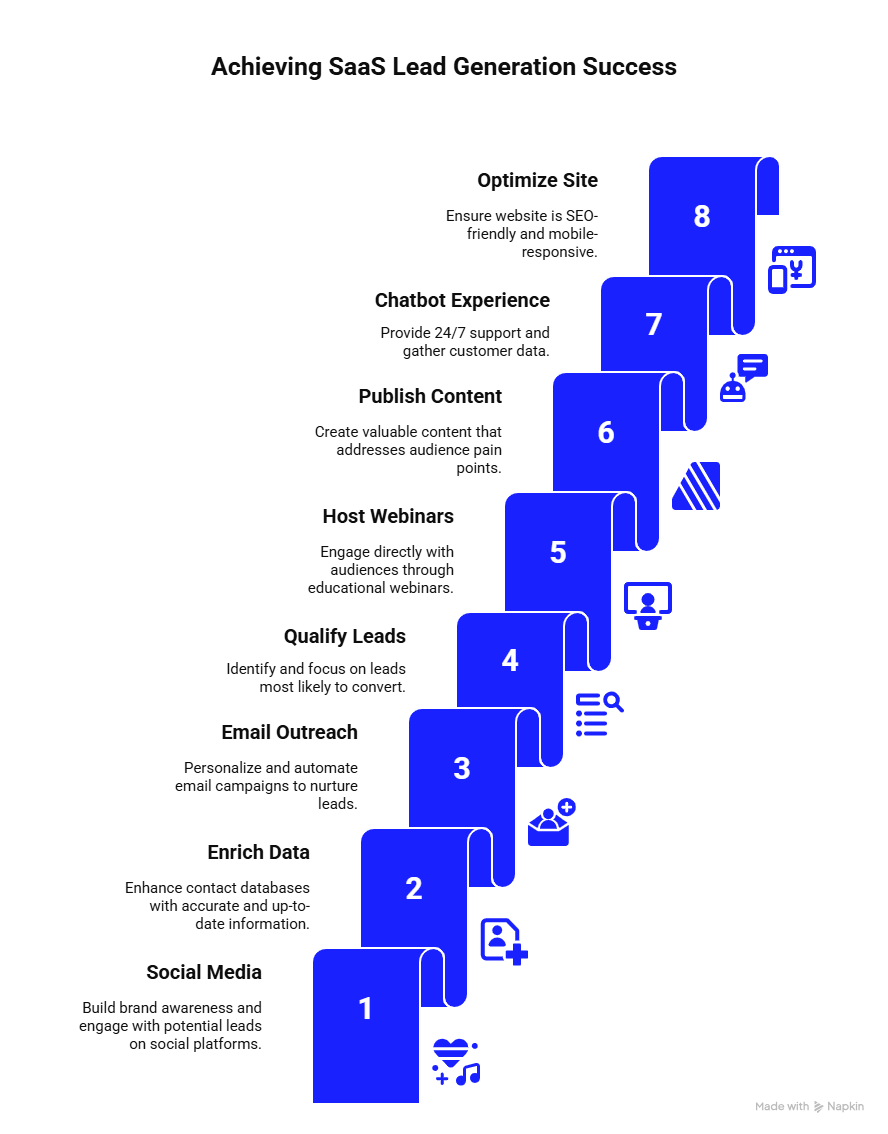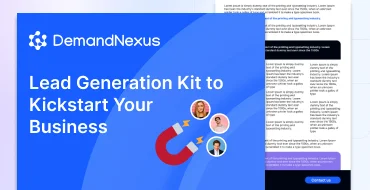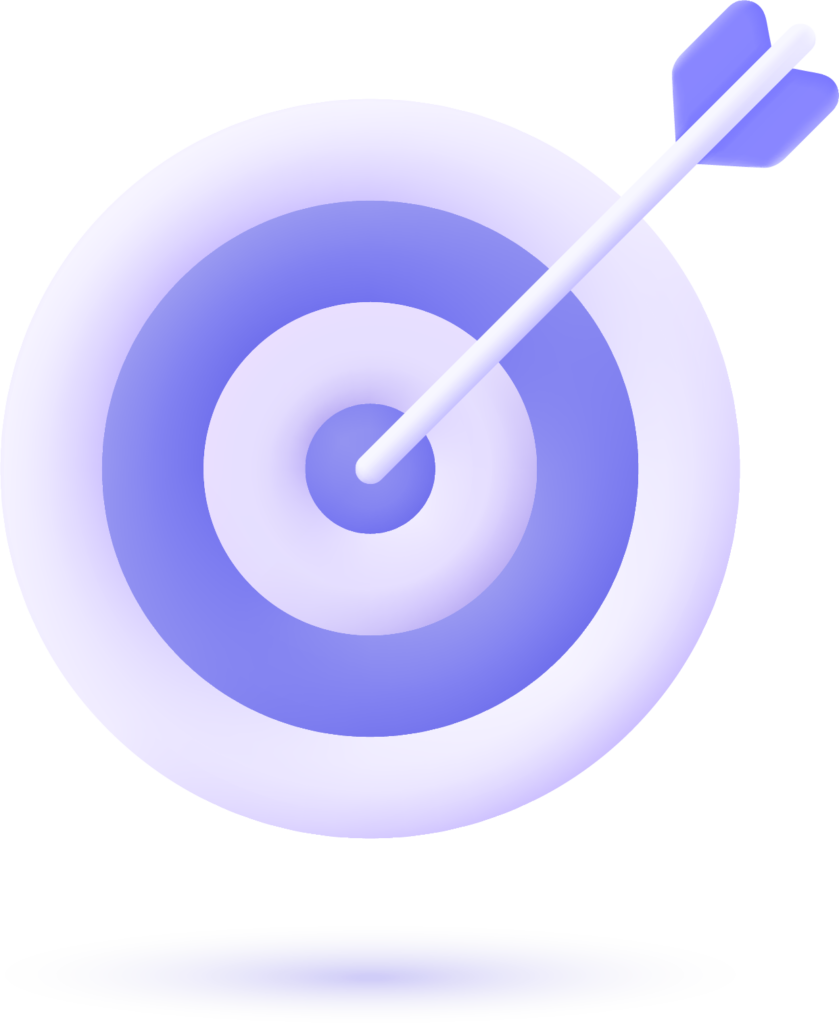Generating high-quality leads is the lifeblood of any B2B SaaS company. In a crowded market where startups, established businesses, and agencies compete for attention, a strategic approach to SaaS lead generation can set you apart. It’s not just about filling your pipeline—it’s about attracting prospects who align with your Ideal Customer Profile (ICP) and nurturing them through a well-crafted funnel to become loyal customers. This in-depth guide explores the art and science of SaaS lead generation, covering inbound and outbound strategies, funnel optimization, and key tools, with a real-world case study showcasing how
DemandNexus drives results.
What Is SaaS Lead Generation?
SaaS lead generation is the process of identifying, attracting, and engaging potential B2B customers interested in your cloud-based software. Unlike traditional lead generation, SaaS focuses on building long-term relationships to drive recurring revenue through subscriptions. It involves a blend of marketing and sales tactics—think
marketing funnels, outbound outreach, and inbound content—to guide prospects from awareness to conversion and retention.
For SaaS startups and established businesses, the stakes are high. B2B buyers are discerning, often involving multiple decision-makers and requiring proof of value. A robust lead generation strategy aligns with their needs, delivering targeted content and personalized outreach to build trust and drive action.

The SaaS Lead Generation Funnel: Mapping the Journey
The SaaS lead generation funnel mirrors the buyer’s journey, guiding prospects through stages of awareness, consideration, conversion, and retention. Here’s how it breaks down:
| Stage |
Goal |
Tactics |
| Awareness |
Attract prospects to your brand |
SEO, content marketing, social media |
| Consideration |
Engage and educate leads |
Webinars, case studies, email nurturing |
| Conversion |
Turn leads into customers |
Free trials, demos, personalized outreach |
| Retention |
Retain and upsell customers |
Customer success, loyalty programs |
Optimizing this funnel requires a mix of inbound and outbound strategies tailored to your audience. Let’s dive into the most effective approaches for B2B SaaS lead generation.
Inbound SaaS Lead Generation: Drawing Prospects In
Inbound strategies focus on attracting prospects organically by providing value upfront. These tactics position your SaaS company as a trusted authority, pulling leads into your funnel naturally.
1. SEO and Content Marketing
High-quality content optimized for search engines is a cornerstone of inbound SaaS lead generation. By addressing your audience’s pain points, you attract prospects actively searching for solutions.
- Strategy: Research keywords related to your SaaS niche using tools like Ahrefs. Create blog posts, eBooks, or videos that answer common questions, such as “How to streamline project management.”
- Example: HubSpot’s blog ranks for thousands of keywords, driving organic traffic to their CRM solutions.
- Tip: Include strong CTAs, like “Download our free guide,” to capture contact details and move leads into your content-driven funnel.
2. Webinars and Events
Webinars showcase your expertise and engage prospects in real time. They’re ideal for educating leads and qualifying them based on participation.
- Strategy: Host webinars on industry challenges, like “Scaling B2B Sales with Automation.” Promote via event marketing channels and follow up with attendees to offer demos.
- Example: ZoomInfo’s webinars feature industry leaders, attracting decision-makers who later convert.
- Tip: Repurpose webinar content into blog posts or social snippets to extend reach.
3. Case Studies and Testimonials
Social proof builds trust. Case studies and testimonials highlight how your SaaS solves real problems, making prospects more likely to engage.
- Strategy: Create detailed case studies with measurable outcomes, like “How Company X Boosted Revenue by 30%.” Share them on your website and in lead nurturing emails.
- Example: Salesforce’s customer success stories showcase ROI, convincing prospects of their platform’s value.
- Tip: Host a webinar featuring a client to bring their story to life.
Outbound SaaS Lead Generation: Taking the Initiative
Outbound strategies involve proactively reaching out to prospects. These tactics are ideal for targeting high-value accounts and accelerating your pipeline.
1. Cold Email Outreach
Cold email outreach connects you directly with decision-makers, offering a cost-effective way to scale
outbound sales.
- Strategy: Build a targeted email list using tools like LinkedIn Sales Navigator. Craft personalized emails with compelling subject lines and follow up consistently.
- Example: A SaaS startup might email CTOs with “Cut Dev Time by 20% with [Product Name].”
- Tip: Use A/B testing to refine subject lines and automate follow-ups with platforms like Saleshandy.
2. Social Selling
Social selling leverages platforms like LinkedIn to build relationships and engage prospects organically.
- Strategy: Share insights, comment on prospect posts, and join industry groups. Use LinkedIn’s advanced search to find ICP-matched leads.
- Example: Gong.io’s sales team shares data-driven posts, positioning themselves as thought leaders.
- Tip: Personalize connection requests to spark conversations.
3. Paid Advertising
Paid ads, like PPC and social media campaigns, deliver instant visibility and precise targeting for
display advertising.
- Strategy: Run LinkedIn ads targeting specific job titles or industries. Bid on high-intent keywords like “best CRM software” for PPC.
- Example: Slack’s LinkedIn ads highlight team collaboration, driving sign-ups.
- Tip: Monitor ROI and adjust targeting to optimize ad spend.
Blending Inbound and Outbound: The Demand Generation Funnel
A demand generation funnel combines inbound and outbound tactics to create a steady stream of qualified leads. Unlike a traditional sales funnel, it emphasizes building awareness and trust before pushing for conversions. Here’s how to structure it:
- Top of Funnel (TOFU): Use demand generation tactics like blogs, social posts, and ads to attract broad audiences.
- Middle of Funnel (MOFU): Engage leads with webinars, case studies, and targeted emails to nurture interest.
- Bottom of Funnel (BOFU): Convert leads with free trials, demos, or appointment-setting to close deals.
For example, Cognism uses its “Easy Mode Framework” to create ungated content that builds trust, feeding leads into targeted outbound campaigns for conversions.
Key Tools for SaaS Lead Generation
The right tools streamline your lead generation efforts, from finding prospects to nurturing them. Here are five essentials:
| Tool |
Purpose |
Example |
| CRM |
Manage leads and track interactions |
HubSpot |
| SEO |
Optimize content for search |
Ahrefs |
| Email Outreach |
Automate and personalize emails |
Saleshandy |
| Chatbots |
Engage visitors 24/7 |
Drift |
| Social Selling |
Find and connect with prospects |
LinkedIn Sales Navigator |
Case Study: DemandNexus Supercharges Lead Generation for a SaaS Startup
A SaaS startup offering HR automation software struggled to generate qualified leads, relying heavily on inconsistent inbound traffic.
DemandNexus stepped in to overhaul their strategy.
- Challenge: Low lead volume and poor conversion rates, with only 10% of leads qualifying as sales-ready.
- Solution: DemandNexus implemented a hybrid approach, combining cold calling and personalized email campaigns with SEO-optimized content. They also used outsourced SDR services to qualify leads using BANT criteria.
- Results: Lead volume increased by 50%, with 35% of leads qualifying as sales-ready. Monthly recurring revenue (MRR) grew by 25% in six months.
DemandNexus’s expertise in blending inbound and outbound tactics, backed by data-driven insights, helps SaaS businesses build scalable lead generation engines. Their services, like
account-based marketing, can target high-value accounts to maximize ROI.
Measuring Success: Key Metrics for SaaS Lead Generation
Tracking metrics ensures your lead generation efforts deliver results. Focus on these KPIs:
| Metric |
Formula |
Why It Matters |
| Cost Per Lead (CPL) |
Marketing Spend / Number of Leads |
Measures cost efficiency |
| Lead-to-Customer Ratio |
(Customers / Leads) * 100 |
Shows conversion effectiveness |
| Conversion Rate |
(Conversions / Total Visitors) * 100 |
Tracks funnel performance |
Use analytics tools like Google Analytics or HubSpot to monitor these metrics and refine your strategy. For example, a high CPL might prompt a shift to more cost-effective channels like
cold email outreach.
Overcoming Common SaaS Lead Generation Challenges
SaaS lead generation isn’t without hurdles. Here’s how to tackle them:
- Low Lead Quality: Use BANT or lead research services to qualify prospects early.
- High Costs: Balance paid ads with organic tactics like SEO to optimize spend.
- Slow Conversions: Offer free trials or streamline sign-up processes to accelerate decisions.
Your Path to SaaS Lead Generation Success
Effective SaaS lead generation blends inbound and outbound strategies to attract, engage, and convert high-quality prospects. Start by defining your ICP and building a demand generation funnel that delivers value at every stage. Use tools to streamline outreach and track metrics to optimize performance. Whether you’re a startup or an established SaaS business, a data-driven approach will fuel growth.
Need a boost?
DemandNexus specializes in crafting tailored lead generation strategies for B2B SaaS companies. From cold outreach to content marketing, their solutions drive qualified leads and revenue. Contact them today to transform your pipeline.





